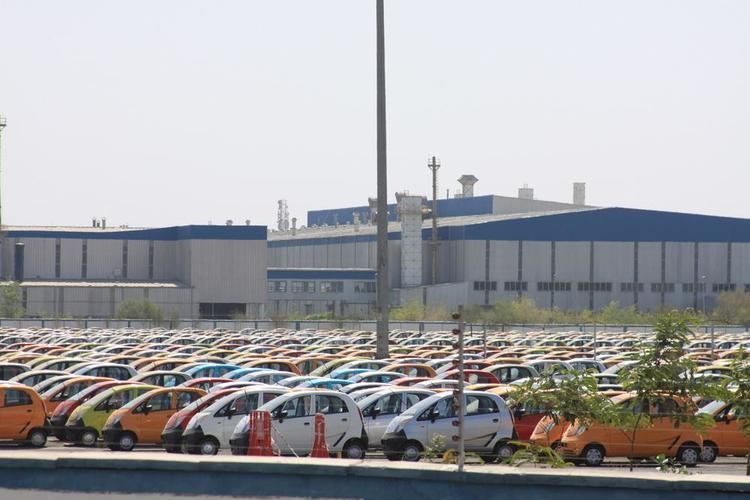Year built January 2010 | ||
 | ||
Industry Passenger vehicle manufacture Similar Vatva railway station, Sarkhej, Ellis Bridge, Kankaria Lake | ||
Sanand Plant is a passenger vehicles manufacturing facility located in Sanand, Gujarat, India, and manufactures the world's cheapest car, the Tata Nano; and is owned and operated by Tata Motors, it is also their newest car manufacturing facility.
Contents
About
Tata Motors’ plant for the Tata Nano at Sanand, located in the Ahmedabad district of Gujarat. The capacity of the plant, to begin with, will be 250,000 cars per year to be achieved in phases, and with some balancing is expandable up to 350,000 cars per year. Provision for further capacity expansion has also been incorporated in this location.
Built in a record time of 14 months starting November 2008, the integrated facility comprises Tata Motors’ own plant, spread over 725 acres, and an adjacent vendor park, spread over 375 acres, to house key component manufacturers for the Tata Nano.
In line with latest world-class manufacturing practices, the Sanand plant has been equipped with state-of-the-art equipment. They include sophisticated robotics and high speed production lines. The plant has energy-efficient motors, variable frequency drives, and systems to measure and monitor carbon levels. These are supplemented with extensive tree plantation, sustainable water sourcing through water harvesting and ground water recharging and using solar energy for illumination; all of this helps the plant to be more sustainable.
In June 2010, the first Nanos made at the plant rolled out from its main manufacturing plant at Northcote Cattle Farm. The construction time was a record breaking 14 months. The cost amounted to 20 Billion Indian Rupees (Ca. 200 Million Euro). During the starting period the production plant employed 2.400 staff. Including the indirect jobs around the plant there were about 10.000 people depending on the initial production. The plant has a capacity to manufacture 250,000 cars a year in the first phase, which will be scaled up to 500,000 cars a year. The project, including the main plant, vendor facilities and a railway transportation hub near Nidhrad Village, will together generate over 20,000 direct and indirect jobs. This plant uses land from Gujarat Agricultural University which was in the name of the Government of Gujarat.
Land controversy
The 1100 acres of land which was allotted to Tata Motors falls in the villages of Khoda and Bol in Sanand Taluka.
The government's move to acquire fertile agriculture lands for industry has agitated the farmers who are dependent on the lands for livelihood . Ever since the notification regarding the acquisition was published by the state revenue department on December 4, farmers to be affected have been holding meetings in Haripura, Charal, Bol and Siyawada villages and have decided to launch an agitation against the acquisition of their lands.They don't want with their land which is fertile and give three crops a year because of irrigation from Narmada canal One farmer Patel said."My extended family of more than 200 people will be workless if the source of our earning is taken away from us," he said ruefully, complaining about the government's move.According to him, the land is fertile and farmers grow paddy, wheat, pulses and vegetables. Farmers don't understand "why the government wants such fertile lands for industry," they asked.Even other farmers to be affected from the move echo similar feelings saying they will be rendered workless if their lands are taken away from them. "We don't want compensation or any relief package in exchange of the land we are depended upon," Ramanbhai Patel, a farmer from Hirapur said, adding that the government should use waste land for industry. The farmers have suggested alternative sites where lands are barren and could be used for industry, he said.
According to one report:
Tata Motors paid Rs 900/sqm (US$81,000 per acre) to the Gujarat Government for the land in Sanand.
Nano story of Sanand farmers
Ahead of the assembly polls, in Sanand, the BJP stronghold, a section of farmers are feeling let down by the acquisition of land and many others are now struggling to find their feet in the new economy.
“I didn’t want to sell my land but the government left us with no alternative. I am a crorepati today but I have lost ancestral land where we grew multiple crops — rice, jowar, wheat. It was hard work but the only work we know,” said Rathod a farmer from Sanad
He is now wondering where to invest money, once his compensation which is in crores comes in and how to make sure that his 15-year-old son Kisan doesn’t get wasted.
Many of the farmers, who sold their land from seven other villages — Hirapur, Gokalpur, Charal, Siyawada, Bol — to GIDC much earlier and raked in lakhs have frittered away their compensation . “Not one person in my village has been hired by the plant, they mostly use labourers from UP and Bihar,” added Rathod, sitting outside his new house. Lalji bhai Shankarji, another farmer who sold his land to GIDC, told HT, “There is development but more for industry and not for us farmers.Although we got good money for our land but lost our livelihood.”
